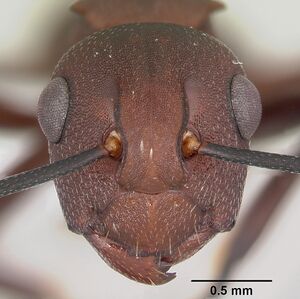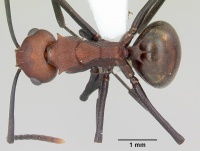Polyrhachis deceptor
| Polyrhachis deceptor | |
|---|---|

| |
| Scientific classification | |
| Kingdom: | Animalia |
| Phylum: | Arthropoda |
| Class: | Insecta |
| Order: | Hymenoptera |
| Family: | Formicidae |
| Subfamily: | Formicinae |
| Tribe: | Camponotini |
| Genus: | Polyrhachis |
| Subgenus: | Myrmothrinax |
| Species: | P. deceptor |
| Binomial name | |
| Polyrhachis deceptor Kohout, 2008 | |
Specimens have been collected from fogging samples in agroforest.
Identification
A member of the Polyrhachis aequalis species group.
Kohout (2008) - Polyrhachis deceptor is similar to Polyrhachis abnormis from New Guinea, and to several undescribed species of the subgenus from Borneo. Polyrhachis deceptor and P. abnormis have the pronotal dorsum irregularly, but mostly longitudinally striate, elongated pronotal spines that are longer than their basal widths, strongly elevated propodeal spines and subequal petiolar spines. Polyrhachis deceptor differs from P. abnormis in having shorter, horizontal and more laterally directed pronotal spines and gently curved, distinctly divergent propodeal spines. The pronotal spines in P. abnormis are distinctly elevated and anterolaterally directed and the propodeal spines are very slender, almost vertical and parallel. The overall colour pattern of both species is similar, yellowish-or light reddish-brown, but the appendages in P. abnormis are concolourous with the rest of the body, while they are dark to very dark brown in P. deceptor. The specimens of P. abnormis from Lore Lindu differ in colour from those from Dumoga-Bone. The type series specimens are distinctly reddish-brown, while those from Lore Lindu are yellowish-brown without a reddish hue.
Keys including this Species
Distribution
Distribution based on Regional Taxon Lists
Indo-Australian Region: Indonesia (type locality), Sulawesi.
Distribution based on AntMaps
Distribution based on AntWeb specimens
Check data from AntWeb
Countries Occupied
| Number of countries occupied by this species based on AntWiki Regional Taxon Lists. In general, fewer countries occupied indicates a narrower range, while more countries indicates a more widespread species. |

|
Estimated Abundance
| Relative abundance based on number of AntMaps records per species (this species within the purple bar). Fewer records (to the left) indicates a less abundant/encountered species while more records (to the right) indicates more abundant/encountered species. |

|
Biology
Castes
Worker
Images from AntWeb
   
| |
| Paratype of Polyrhachis deceptor. Worker. Specimen code casent0103187. Photographer April Nobile, uploaded by California Academy of Sciences. | Owned by NHMUK, London, UK. |
Nomenclature
The following information is derived from Barry Bolton's Online Catalogue of the Ants of the World.
- deceptor. Polyrhachis deceptor Kohout, 2008a: 307, figs. 11G-H (w.q.) INDONESIA (Sulawesi).
Unless otherwise noted the text for the remainder of this section is reported from the publication that includes the original description.
Description
Worker
(holotype cited first): TL c. 6.15, 6.10-6.75; HL 1.65, 1.59-1.75; HW 1.40, 1.34-1.50; CI 85, 84-86; SL 2.03, 1.93-2.18; SI 145, 141-150; PW 0.90, 0.84-1.00; MTL 2.21, 2.15-2.40 (7 measured).
Anterior clypeal margin with medial, widely and shallowly emarginate truncation, flanked by distinct teeth. Clypeus with blunt, posteriorly distinct median carina; clypeus very weakly convex in profile, abruptly rounding into rather shallow basal margin, laterally basal margin indicated by a thin, sculpture-breaking line. Frontal triangle indistinct. Frontal carinae sinuate with margins very narrowly, vertically raised; central area relatively wide, weakly convex medially, with shallow frontal furrow. Sides of head in front of eyes weakly convex, converging towards mandibular bases; behind eyes sides broadly rounding into convex occipital margin. Eyes convex, in full face view clearly exceeding lateral cephalic outline. Ocelli lacking. Pronotal humeri armed with relatively long, laterally directed spines; outer edges of spines continuous with somewhat sinuate lateral pronotal margins. Promesonotal suture distinct. Mesonotum with lateral margins strongly converging and somewhat raised posteriorly, shallowly emarginate medially; dorsum in profile distinctly stepping down into metanotal groove. Propodeum rather flat with lateral margins terminating posteriorly in almost vertically elevated, gently curved, weakly divergent spines; propodeal dorsum descending into oblique declivity in medially uninterrupted line. Petiole with anterior face flat, posterior face convex; dorsum armed with three, rather long, acute, dorsoposteriorly directed, subequal spines, lateral pair distinctly diverging. Anterior face of first gastral segment widely rounding onto dorsum.
Mandibles very finely reticulate. Head, mesosoma and petiole reticulate-punctate; pronotal dorsum with weak, irregular but largely longitudinal striae that are bowed towards posterolateral pronotal angles. Dorsum of mesonotum and propodeum reticulate-rugose, with sides of mesosoma densely and regularly reticulate-punctate. Gaster finely shagreened.
Mandibular masticatory borders with only a few, curved, golden hairs and numerous very short hairs arising from pits towards bases. Anterior clypeal margin with several rather short setae. A few pairs of relatively short, erect hairs near anterior and basal clypeal margins, along frontal carinae and a single pair of slightly longer hairs on vertex. Anterior face of fore coxae with pair of erect hairs that are almost as long as greatest diameter of eye. Gaster with very short erect hairs on posterodorsal margins of apical segments; more abundant, longer hairs lining margins of segments on gastral venter. Very short, closely appressed, somewhat diluted, golden pubescence over most body surfaces; pubescence dense and pale on dorsum of first gastral segment, almost white towards sides.
Colour. Distinctly light reddish-brown, with clypeus, central area, condylae and most of last funicular segment lighter, yellow-orange. Vertex with dark reddish, diffuse patch medially. Mandibles, coxae and legs very dark, reddish-brown, with antennal scapes almost black. Anterior clypeal margin, frontal carinae, condylae, mandibular bases, border along pronotal collar and very narrow border along lateral margins of pronotum, mesonotum and propodeum, including spines, very dark reddish-brown. Dorsum of first gastral segment reddish-brown, distinctly more yellowish than head and mesosoma. Rest of gaster distinctly darker, reddish-brown with segments somewhat diffusely bordered with very dark reddish-brown.
Queen
TL c. 8.21-8.52; HL 1.96-2.00; HW 1.65-1.68; CI 84-86; SL 2.21-2.34; SI 134-139; PW 1.62-1.65; MTL 2.46-2.58 (3 measured).
Very similar to worker with usual differences indicating caste, including three ocelli and complete thoracic structure. Pronotal humeri produced into blunt teeth; mesoscutum with lateral margins converging anteriorly towards rather narrowly rounded anterior margin; median line distinct, bifurcate; parapsides flat; mesoscutellum moderately elevated above dorsal plane of mesoscutum. Propodeum armed with somewhat dorsally flattened, weakly divergent, upturned spines; petiolar spines more massive and shorter than in worker, with median spine marginally shorter than lateral pair. Dorsum of mesoscutum and mesoscutellum with numerous, moderately long, semierect hairs that are completely absent in workers. Sculpturation and colour virtually as in worker.
Type Material
HOLOTYPE: SULAWESI UTARA: Dumoga-Bone NP, nr Danau Mooat, 1100m, 1.viii.1985, coffee fog., N.E. Stork et al. (worker). PARATYPES: data as for holotype (6 workers). Holotype and 2 paratypes in The Natural History Museum; 1 paratype each in Australian National Insect Collection, California Academy of Sciences, Museum of Comparative Zoology and Queensland Museum.
References
- Blanchard, B.D., Nakamura, A., Cao, M., Chen, S.T., Moreau, C.S. 2020. Spine and dine: A key defensive trait promotes ecological success in spiny ants. Ecology and Evolution 10, 5852–5863 (doi:10.1002/ECE3.6322).
- Kohout, R.J. 2008a. A review of the Polyrhachis ants of Sulawesi with keys and descriptions of new species (Hymenoptera: Formicidae: Formicinae). Memoirs of the Queensland Museum. 52:255-317.
References based on Global Ant Biodiversity Informatics
- Kohout, R. J. 2008. A review of the Polyrhachis ants of Sulawesi with keys and descriptions of new species (Hymenoptera: Formicidae: Formicinae). Memoirs of the Queensland Museum 52:255-317.

